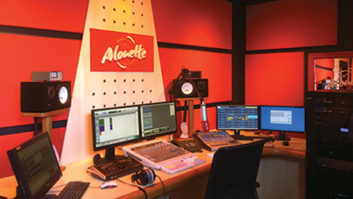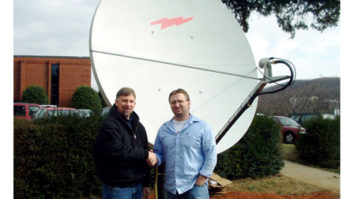Wise Satellite Receivers
Nov 1, 2009 12:00 PM, By Conrad Trautmann, CPBE
Trends in Technology, Nov 2009
The top questions radio station engineers ask about the radio networks satellite delivery systems are, �Why are there so many different manufacturers of receivers? Wasn’t it better when the major networks used the same receiver? Now I have a rack full of receivers that all work differently from each other and they take up more space.�
A big reason is the introduction of store and forward technology a few years back that requires a closed loop network in order to work properly. Store and forward allows the radio networks to do what the advertising world commonly calls copy splitting. The network uploads the commercials in advance to the satellite receiver in a digital file format and they reside on the receiver’s hard drive or flash RAM card and wait for a command to play. At the appropriate time during a commercial break, the head-end sends the command (or trigger) and the spot plays from the satellite receiver instead of streaming from the network head-end. Consider the possibilities. In a network with 2,000 satellite receivers, 2,000 different ads could play out of each of those receivers at the same moment. In reality, that’s a highly unlikely scenario, but it is possible. The technology gives the networks the ability to be more geographically targeted for their advertisers by offering the ability to regionalize ad campaigns.
Store and forward depends on the receiver always being tuned to its home network so those file transfers make it to the receiver. They are uploaded via a data channel reserved for those file transfers. When this was deployed by Premiere and ABC on the Starguide III system using the EDAS card, a challenge both networks faced was stations tuning away from their carrier to pick up a program on a competing network. While the receiver was tuned away the spots wouldn’t be transferred to the receiver and they wouldn’t play.
Back to the original question; �Why different systems?� There are definitely other factors that entered into the selection of a manufacturer by the networks including price, long term support, system design and features. However, because of store and forward, there is a strong desire for each network to maintain a secure system to make sure their receivers always remain tuned to their home network in order to facilitate successful file transfers. As described above, a common platform actually created more problems for the networks. Even if all of the networks had selected the same manufacturer to replace Starguide, stations would have still needed a receiver for each network in order to maintain that closed system approach.
Looking at the playing field today, Jones Radio Network, now owned by Dial Global ,the BBC and EMF chose Wegener as their new platform. National Public Radio and Westwood One selected International Datacasting (IDC). ABC, who is now owned by Citadel Media and Premiere Radio Networks who is owned by Clear Channel both selected X-Digital (XDS).

Wegener Ipump 6420. The major networks now use one of three receivers.

X-Digital XDS-Pro. The major networks now use one of three receivers.

IDC SFX 3100. The major networks now use one of three receivers.
The current generation of satellite receivers offer many new features. Some are shown in the sidebar [see link below]. Let’s explore more in depth what these devices can do.
— continued on page 2
Modern Satellite Receiver Features
A URL You Should Know
ESE World Skies has some useful information on satellite technology on its website….
Contributor Pro-File: Conrad Trautmann, CPBE
This month: Conrad Trautmann, CPBE; EVP, Technology; Dial Global Radio Networks; New York…
Wise Satellite Receivers
Nov 1, 2009 12:00 PM, By Conrad Trautmann, CPBE
Trends in Technology, Nov 2009
- Channel changing. It’s now possible on these systems to make maximum use of the audio cards. Before, with the Starguide platform if your station took more than one show from a network at different times during the day, you either needed to have someone change the channel manually, automate the channel change using some type of serial command from an automation system or third-party device, or use more than one output card from the receiver and tie up multiple inputs on the router or console.
Now, it’s possible to pre-program channel changes on a schedule so all of the programs come out of the same audio card on the receiver (provided the shows don’t run concurrently). All of the programming uses only one audio card, which makes station engineers happy because they only need one input to their equipment for multiple programs from the same network. Engineers are also happy that they can automate this and not depend on human interaction to make the switches. As a result of this efficiency, manufacturers were able to design the receivers with fewer audio cards. Most networks have either two or four audio cards available on their receivers. Some networks provide direct control of this function while others provide this as a service through the network uplink.Also gone from most networks is the old left-channel/right-channel audio split to carry two mono programs on a single stereo feed. A program is now on its own channel, no longer sharing one half of a stereo pair. - Time shifting. Many people refer to this as Tivo-type function because it works in a similar fashion. It’s possible on most of the systems to save a program on the receiver’s hard drive or flash memory as it’s playing live and play it out at a later time. This eliminates the need for the station to tie up their automation system to do those recordings and playbacks freeing up resources.
- Logging. A great troubleshooting tool, most receivers now have logging built in, which is accessible via a Web interface. If you experience a loss of audio, you can check to see what the receiver signal strength was at the time. Or if you miss a relay closure, you can determine if the receiver actually received the trigger to help determine the cause of the problem. This allows the station to investigate issues directly without the need to contact the network’s headend.
- Web interface. Virtually all of the receivers have a way to reach a dashboard via the Web that allows you to view system receive parameters and make system configuration changes. In some cases you can program your channel time shifting for channel changes from here, in others you may need to go to an Internet Web interface for that. Some networks allow access to their audio files stored on the hard drive through the Web interface, FTP, windows share or other methods as well.
The new receiver platforms, being software based allow the use of higher reduction audio algorithms such as MP3, AAC and others. In any case, engineers have noticed and reported improvement in quality when swapping from the legacy systems to the newer ones. - Audio quality improvements. The new fleet of receivers from all of the manufacturers have improved audio quality. There have been many advances in DSP power and the quality of linear analog audio ICs since the design of older systems.
- Program associated data. With the wide use of RBDS and HD Radio, delivering PAD took on a new sense of urgency. Most of the networks have the ability now to deliver title and artist info to the back of the receiver for use to feed those systems.
- Automation. Some networks offer the ability to program your own triggers on the system. Rather than depend on a network trigger at the time you want, you have the ability to program a one-time trigger or recurring trigger to close a relay when you need to. A common use of this is a top of the hour trigger, which many stations like in order to synchronize their automation systems to the network.
- More relays available. On some of the legacy systems, in some cases the maximum number of relays available per program was two. Now that’s climbed to a minimum of four and in many cases 16 relays per channel is a standard.
- Software upgradeable. All of the current generation of receivers are able to be upgraded over the air with new software. The predominant platform is a specialized Linux kernel that allows a tremendous degree of flexibility. This isn’t new, since Starguide also had the capability, but these newer receivers have much more upgrade flexibility than the older systems.
The latest generation of satellite receivers are clearly the most advanced that we’ve seen so far. The fact that there are competing systems is probably a benefit for the stations since competition will drive company research and development, leading to new features.Trautmann is the EVP Technology, Dial Global, New York City.










